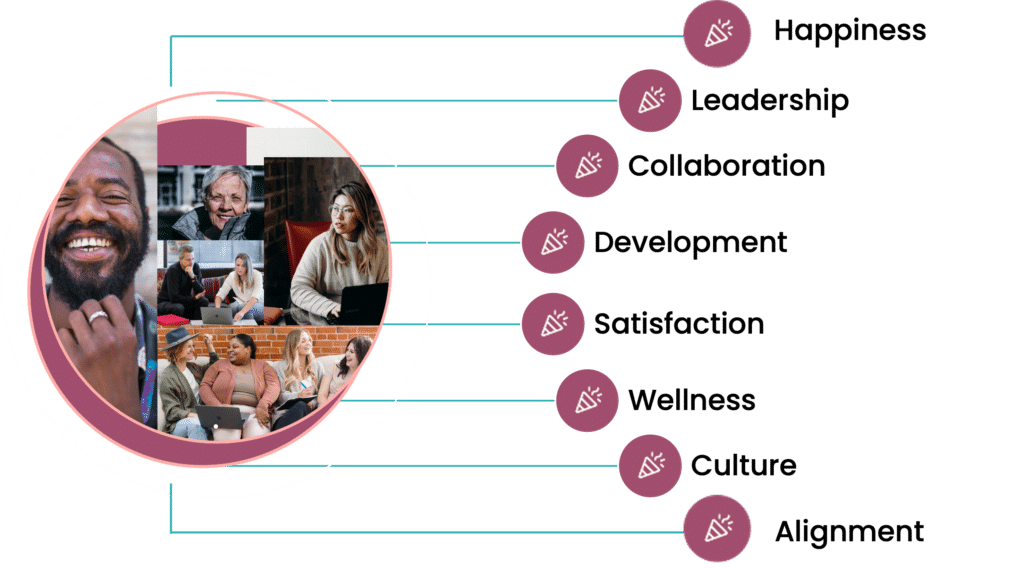Table of Contents
The complete guide to employee engagement software

Employee engagement is a critical part of any successful business, but measuring and improving it can be a challenge. This is where employee engagement software comes in. Designed to help companies measure, track, and improve employee engagement levels, these tools help you to create a more engaged and productive workforce. In this article, we take a closer look at employee engagement software, what it is, and how it will benefit you and your employees.
What do we mean by employee engagement and why is everybody talking about it?
When we talk about employee engagement, we’re referring to the emotional connection and commitment that employees have towards their work and organisation. How motivated are they towards achieving the goals of the organisation? What are their levels of enthusiasm and dedication? Do your employees actually like going to work, or are they plagued by the Sunday Scaries?
One of the most appealing benefits of employee engagement is that it directly impacts the bottom line. Engaged employees are more likely to be happy with their jobs, stay longer with the company, and make positive contributions to the workplace culture.
According to a Gallup study, companies with highly engaged employees experience 21% higher productivity and 22% higher profitability than those with disengaged employees. Additionally, engaged employees tend to be more innovative, coming up with good ideas that can lead to increased revenue and growth opportunities.
And if you’re not already convinced, here are a few more facts and figures that highlight the importance of investing in employee engagement:
- According to a report by the Harvard Business Review, companies with high employee engagement levels have a 4.5 times higher revenue growth rate than those with low engagement levels.
- A Gallup poll found that organisations with high employee engagement have 70% fewer safety incidents that those with low engagement.
- A study by the Society for Human Resource Management found that employee engagement is the top HR challenge for organisations.
Get a sneak peek at Netigate EX, the brand new employee engagement solution.

Sign up for Netigate EX to find out what’s driving engagement at your company.
What is employee engagement software?
Employee engagement software is a tool or platform that helps you to measure, track, and boost employee engagement levels. The software provides a range of features to support employee engagement initiatives, including surveys, feedback tools, performance tracking, and analytics.
These employee engagement tools typically include features such as pulse surveys, which are short surveys sent on a regular basis to measure engagement levels. These surveys can provide valuable insights into the factors that impact employee engagement. E.g. workplace culture, job satisfaction, and leadership.
Other features you can expect to see in good employee engagement software include:
- Performance management: Tools for tracking employee performance and setting goals for improvement.
- Learning and development: Tools for providing employees with training and development opportunities to help them grow and advance in their careers.
- Analytics: Tools for tracking and analysing engagement data to identify trends and areas for improvement.
What are the business benefits of using employee engagement software?
Improved employee engagement
By providing a platform for employee feedback, where they can voice concerns and share ideas, employee engagement software can help improve engagement levels, create a more positive work environment, and boost employee satisfaction.
Increased productivity and performance
Engaged employees are more productive and perform better. Research has found that companies with high levels of employee engagement showed a 10% increase in customer satisfaction, a 22% increase in profitability, and a 21% increase in productivity.
Employee engagement software can help identify areas where employees may be disengaged and provide insights into how to improve productivity and performance.
More informed decision-making
The data provided by employee engagement software can help managers make more informed decisions about employee engagement initiatives, performance management, and learning and development opportunities.
This is good news for individuals, but it also reflects well on HR departments. A Deloitte report showed that data-driven HR departments are 4 times more likely to be respected by their business counterparts for their ability to make informed decisions. Furthermore, the same report found that companies with sophisticated analytics tools were 2.6 times more likely to outperform their peers in profitability.
Higher retention rates
Poor employee retention is costly for businesses. A study by Work Institute found that the average cost of employee turnover was 15,000 USD per employee. Alongside the financial hit, you also lose valuable experience and expertise.
Engaged employees are more likely to stay with an organisation, reducing turnover and associated costs. According to the Corporate Leadership Council, they are 87% less likely to leave their company than their disengaged counterparts.
Employee engagement software can help organisations identify factors that contribute to turnover and implement strategies to retain top talent.
Enhanced employer brand
A positive and engaged workforce can enhance an company’s employer brand. This makes it more attractive to potential hires and improves its reputation within the industry. And this is high on the agenda of global talent acquisition professionals, with 62% stating that their top priority is improving their company’s employer brand.
Furthermore, the same report from LinkedIn found that that companies with highly engaged employees receive twice as many job applications as those with low engagement levels.
What is employee disengagement costing your business? Try our employee experience ROI calculator.
How does engagement software benefit employees?
We’ve looked at why engagement tools are good for businesses, but what benefits do they bring to your individual employees?
Opportunities for professional development and personal growth
Tools like Netigate EX allow you to give your employees a voice and understand what they need to thrive in their careers. Research shows that this is important, with 86% of employees citing “career growth opportunities” as a critical factor in job satisfaction.
The same survey also found that 69% of employees would stay with their current employer if they felt there was a clear career path.
Regular feedback and employee recognition
Engagement software helps you to develop a company culture of regular feedback and recognition. According to a survey by TINYpulse, 43% of highly engaged employees receive feedback at least once a week. This is compared to only 18% of disengaged employees.
Furthermore, a report by Globoforce found that companies with recognition programs that are highly effective at improving employee engagement have 31% lower voluntary turnover rates.
Improved mental health
EX software helps you to nurture a culture of engagement, and people who are engaged at work tend to have better mental health and lower stress levels. According to a Gallup study, they are 28% less likely to experience stress and 40% less likely to experience burnout.
On the other hand, disengaged employees are more likely to experience feelings of isolation, boredom, and frustration. All of which can have a negative impact on mental health.
What to consider before you invest in an employee engagement tool
- Features: Consider the features you need to effectively measure and boost engagement. Do you need pulse surveys, recognition and rewards platforms, communication tools, performance management features, or learning and development tools? Make sure the software you choose offers the features that align with your company’s goals.
- Ease of use: Look for software that is user-friendly and easy to navigate. It should be easy for employees to use and for managers to access the data they need.
- Customisation: Consider whether the software can be customised to meet your company’s specific needs. Customisation options may include the ability to add your company logo, modify survey questions, or tailor the software to your industry.
- Integration: Think about whether the software can be integrated with your existing HR systems. E.g. Your HRIS or performance management software. Integration can help streamline processes and provide a more complete picture of employee engagement levels.
- Support: Consider the level of support offered by the software provider. Look for providers that offer training and support to help your organisation get the most value out of the tool.
- Cost: Evaluate the costs associated with the software, including any setup fees, subscription fees, or additional costs for customisation or support. Make sure the software fits within your budget and offers good value for the features provided.
-
Natasha Ellis-Knight
-
Natasha Ellis-Knight
- 6 min read
- .






